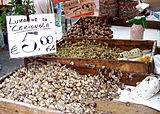|
Arctica islandica
 The ocean quahog (Arctica islandica) is a species of edible clam, a marine bivalve mollusk in the family Arcticidae. This species is native to the North Atlantic Ocean, and it is harvested commercially as a food source. This species is also known by a number of different common names, including Icelandic cyprine,[1] mahogany clam, mahogany quahog, black quahog, and black clam.[2] The typical A. islandia resembles the quahog, but the shell of the ocean quahog is rounder, the periostracum is usually black, and on the interior of the shell, the pallial line has no indentation, or sinus. Unlike the quahog, which lives intertidally and can be collected by clam digging, this species lives subtidally, and can only be collected by dredging. They grow to sizes exceeding 50 mm or two inches shell height.[3] An individual specimen was reported to have lived 507 years, making it the longest-lived non-colonial metazoan whose age was accurately known.[4] Life cycle and longevityA. islandia shows slower growth rate than other species of clams, it takes an average rate of 4 days for birth (embryo to larvae stage). Furthermore, it takes an average of 5.8 years for A. Islandica to reach maturity; at this point the somatic costs start going down. Dynamic Energy Models (DEM) predict that A. islandia's extreme longevity arises from lowered somatic maintenance costs and a low aging acceleration.[5] For individuals in populations in cold areas the growth rate is probably further slowed because growth occurs only in summer.[6] This slow life style results in exceptional longevity, e.g., with a reported age, for Ming the clam, of 507 years. It is the longest lived non-colonial metazoan species with an authenticated lifespan.[4][7][8] It is unknown how long it could have lived had it not been collected alive by a 2006 expedition. This characteristic has proven useful in the science of sclerochronology, the study of periodic physical and chemical features in the hard tissues of animals that grow by accretion, and is especially valuable for modeling of paleoclimates. In 1868 one specimen, collected alive near Iceland, was 374 years old. The study of its growth rate and the oxygen isotope data showed that it had a highly variable growth at the peak of the Little Ice Age around 1550–1620 and mild climate near its end around 1765–1780 and had recorded the volcanic eruption of Mount Tambora in 1815.[9] One study found that in animals aged 4–192 years, antioxidant enzymes declined rapidly in the first 25 years, which includes the growth and sexual maturity stages, but afterwards remained stable for over 150 years. Though more detailed studies are warranted, it appears this species is a case of negligible senescence.[10] In contrast to the exceptionally long-lived populations in relatively deep, cold parts of its range, more southern populations that experience greater seasonal variations in salinity and temperature are typically far shorter-lived. For example, A. islandica from the German Bay of Kiel typically only reach an age of about 30 years and those from the German Bight about 150.[11] Feeding ecologyLike other clam species, A. islandia is a filter feeder. Feeding activity appears regulated by light levels, which can be used as a proxy for food availability. This means that at the northern extreme of the distribution, feeding is concentrated during eight months of the year, while during the rest of the year the clams only feed for a few days a month.[6] See alsoNotes
External linksWikimedia Commons has media related to Arctica islandica. |
||||||||||||||||||||||||||||||



